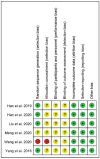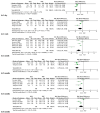Comparing the efficacy and safety of short-term spinal cord stimulation and pulsed radiofrequency for zoster-related pain: A systematic review and meta-analysis
- PMID: 35356934
- PMCID: PMC10684147
- DOI: 10.1097/MD.0000000000029073
Comparing the efficacy and safety of short-term spinal cord stimulation and pulsed radiofrequency for zoster-related pain: A systematic review and meta-analysis
Abstract
Background: Pulsed radiofrequency (PRF) is a commonly used method for the treatment of zoster-related pain in the clinic. However, PRF therapy has a high recurrence rate and many adverse reactions. Recent studies have shown that short-term spinal cord stimulation (stSCS) can effectively alleviate zoster-related pain. Due to the lack of evidence, it is unclear whether stSCS is superior to PRF in the efficacy of treating zoster-related pain.
Objective: This study aimed to compare the efficacy and safety of stSCS and PRF for zoster-related pain.
Methods: We searched seven electronic databases from the establishment of the database to January 2021. Related randomized controlled trials were included in this meta-analysis. After extracting the data and evaluating the methodological quality of the included trials, the outcome indicators were statistically analyzed by using RevManV.5.3.
Results: This meta-analysis included 6 trials with a total of 509 patients. Compared with PRF group, stSCS group showed lower pain intensity (standardized mean difference=-0.83, 95%CI [-1.37, -0.30], P=.002), better sleep quality (mean difference=-1.43, 95%CI [-2.29, -0.57], P=.001), lower pain rating index scores, and less incidence of adverse events (RR=0.32, 95%CI [0.12, 0.83], P<.05). However, the efficacies of PRF and stSCS for treating postherpetic neuralgia were consistent in the response rate (RR= 1.10, 95% CI [0.82, 1.48], P=.51) and the complete remission rate (RR=1.05, 95% CI [0.66, 1.68], P=.84).
Conclusions: In this study, stSCS showed a better analgesic effect and higher safety than PRF. Our meta-analysis results suggested that stSCS may be a feasible and safe invasive treatment for zoster-related pain. However, high-quality, randomized controlled trials with large sample sizes are needed to further verify our conclusions.
Copyright © 2022 the Author(s). Published by Wolters Kluwer Health, Inc.
Conflict of interest statement
The authors have no conflicts of interest to disclose.
Figures













Similar articles
-
Efficacy of Pulsed Radiofrequency or Short-Term Spinal Cord Stimulation for Acute/Subacute Zoster-Related Pain: A Randomized, Double-Blinded, Controlled Trial.Pain Physician. 2021 May;24(3):215-222. Pain Physician. 2021. PMID: 33988940 Clinical Trial.
-
Short-Term Spinal Cord Stimulation or Pulsed Radiofrequency for Elderly Patients with Postherpetic Neuralgia: A Prospective Randomized Controlled Trial.Neural Plast. 2022 Apr 27;2022:7055697. doi: 10.1155/2022/7055697. eCollection 2022. Neural Plast. 2022. PMID: 35529453 Free PMC article. Clinical Trial.
-
Efficacy of Short-Term Spinal Cord Stimulation in Acute/Subacute Zoster-Related Pain: A Retrospective Study.Pain Physician. 2017 Jul;20(5):E633-E645. Pain Physician. 2017. PMID: 28727708
-
Efficacy and safety of pulsed radiofrequency combined with pregabalin for herpetic neuralgia: A systematic review and meta-analysis.Medicine (Baltimore). 2023 Jun 9;102(23):e33932. doi: 10.1097/MD.0000000000033932. Medicine (Baltimore). 2023. PMID: 37335664 Free PMC article.
-
Efficacy of Pulsed Radiofrequency in Herpetic Neuralgia: A Meta-Analysis of Randomized Controlled Trials.Clin J Pain. 2020 Nov;36(11):887-895. doi: 10.1097/AJP.0000000000000867. Clin J Pain. 2020. PMID: 32701526
Cited by
-
Comparison of a One- versus Two-Week Treatment with Famciclovir Upon Reductions in Pain and Occurrence of Postherpetic Neuralgia in Herpes Zoster: A Randomized Open-Label Trial.Infect Drug Resist. 2023 Feb 2;16:721-726. doi: 10.2147/IDR.S385442. eCollection 2023. Infect Drug Resist. 2023. PMID: 36756610 Free PMC article.
-
Clinical study of short-term spinal cord stimulation for herpes zoster-associated pain.Eur J Med Res. 2024 Dec 19;29(1):603. doi: 10.1186/s40001-024-02196-6. Eur J Med Res. 2024. PMID: 39702473 Free PMC article.
-
Efficacy and Safety of Pulsed Radiofrequency in Herpes Zoster Related Trigeminal Neuralgia: A Systematic Review and Meta-Analysis.J Pain Res. 2023 Feb 2;16:341-355. doi: 10.2147/JPR.S396209. eCollection 2023. J Pain Res. 2023. PMID: 36756203 Free PMC article. Review.
-
Comparative long-term efficacy of short-term spinal cord stimulation versus bipolar pulsed radiofrequency for refractory postherpetic neuralgia: a 24 month prospective study.Eur J Med Res. 2025 Apr 12;30(1):272. doi: 10.1186/s40001-025-02560-0. Eur J Med Res. 2025. PMID: 40221810 Free PMC article.
-
The efficacy and prognosis analysis of short-term spinal cord stimulation in the treatment of zoster-associated pain: a retrospective study.Front Neurol. 2025 Jul 11;16:1611447. doi: 10.3389/fneur.2025.1611447. eCollection 2025. Front Neurol. 2025. PMID: 40718098 Free PMC article.
References
-
- Schmader K. Herpes zoster. Ann Intern Med 2018;169:ITC19- 31. - PubMed
Publication types
MeSH terms
LinkOut - more resources
Full Text Sources
Medical

